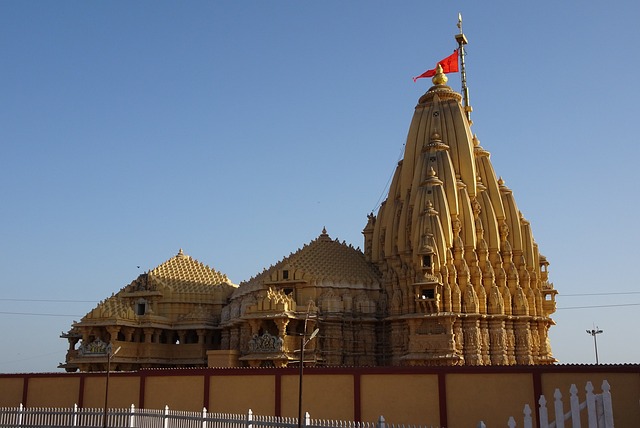Somnath: The First Jyotirlinga in Gujarat
What is a Jyotirlinga?
A Jyotirlinga is a sacred shrine dedicated to Lord Shiva, representing his infinite cosmic power. There are 12 Jyotirlingas in India, and Somnath is considered the first among them. These Jyotirlingas are believed to be self-manifested and hold immense spiritual significance for devotees. Visiting these sites is considered one of the best travel experiences for spiritual seekers.
Why is Somnath One of the Jyotirlingas?
Somnath is known as the “Eternal Shrine”, holding a divine presence that has withstood the test of time. According to legend, the Moon God (Chandra) built this temple to seek forgiveness from Lord Shiva. It is believed that visiting Somnath grants liberation from worldly sufferings and bestows divine blessings. This makes it a must-visit destination for those who wish to explore India through its rich spiritual heritage.
Location of Somnath
Somnath is located in Prabhas Patan, near Veraval in Gujarat. Overlooking the Arabian Sea, the temple stands as a magnificent symbol of faith and devotion.
- State: Gujarat
- District: Gir Somnath
- Nearest City: Veraval (7 km away)
- Nearest Airport: Diu Airport (85 km away)
- Nearest Railway Station: Veraval Railway Station (7 km away)
How to Reach Somnath?
By Air
The nearest airport is Diu Airport, which is 85 km away. From there, taxis and buses are available to Somnath.
By Train
The nearest railway station is Veraval Railway Station (7 km away), which connects Somnath to major cities like Ahmedabad, Rajkot, and Mumbai.
By Road
Somnath is well-connected by road with major cities in Gujarat. You can travel by bus, taxi, or private vehicle from:
- Ahmedabad (410 km)
- Rajkot (195 km)
- Junagadh (85 km)
Best Time to Visit Somnath
The ideal time to visit Somnath is between October and March, when the weather is pleasant for temple visits and sightseeing.
Season-wise Travel Guide
- Winter (October – March): Best time for pilgrimage and tourism.
- Summer (April – June): Hot and humid but suitable for spiritual visits.
- Monsoon (July – September): Lush greenery and occasional rainfall enhance the beauty of the temple surroundings.
Importance of Visiting Jyotirlingas
Visiting a Jyotirlinga is considered a path to spiritual enlightenment and liberation from sins. It is believed that offering prayers at a Jyotirlinga strengthens one’s spiritual journey and grants peace, prosperity, and divine protection. If you love exploring India through its sacred places, then the Somnath Jyotirlinga should definitely be on your travel list.
History Behind Somnath Temple
Mythological Significance
According to Hindu mythology, Chandra (Moon God) was cursed by his father-in-law, King Daksha, to lose his radiance. He prayed to Lord Shiva at Somnath, who blessed him and partially lifted the curse. Hence, Somnath means “The Lord of the Moon”.
Historical Significance
Somnath Temple has been rebuilt multiple times due to foreign invasions:
- First built by Chandra Deva (according to legend).
- Reconstructed by the Yadava Kings in ancient times.
- Destroyed and rebuilt several times between the 11th and 18th centuries.
- The current temple was rebuilt in 1951 under the leadership of Sardar Vallabhbhai Patel.
Architectural Marvel of Somnath Temple
The present Somnath Temple is built in the Chalukya style of architecture. It features:
- Magnificent Shikhar (tower) rising to 50 meters.
- Intricate carvings and sculptures representing Hindu mythology.
- An awe-inspiring sea-facing location, where the Triveni Sangam (confluence of three rivers) meets the Arabian Sea.
- A grand Somnath Light and Sound Show, depicting the temple’s history every evening.
Things to Do in Somnath
- Visit Somnath Temple – Seek blessings at one of the most sacred Jyotirlingas.
- Explore Triveni Sangam – The holy confluence of Hiran, Kapila, and Saraswati rivers.
- Attend the Evening Aarti – Experience the divine energy of temple prayers.
- Watch the Light & Sound Show – Learn about the rich history of Somnath.
- Visit Bhalka Tirtha – The site where Lord Krishna is believed to have left his mortal body.
- Explore Prabhas Patan Museum – Discover ancient relics and temple artifacts.
- Enjoy the Scenic Arabian Sea View – The temple’s location provides a breathtaking coastal view, making it an unforgettable explorewithme moment.
Conclusion
Somnath is not just a temple; it is a symbol of devotion, resilience, and divinity. Whether you seek spiritual peace, historical insights, or architectural beauty, Somnath offers an unparalleled experience.
For those who wish to explore India through its spiritual landmarks, Somnath stands as a timeless beacon of faith. Plan your visit to this sacred destination and immerse yourself in its spiritual grandeur. Whether you are a pilgrim or a traveler, visiting Somnath is undoubtedly one of the best travel experiences you can have.

